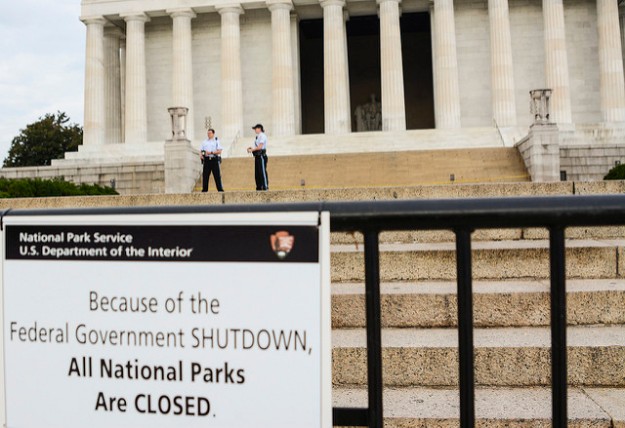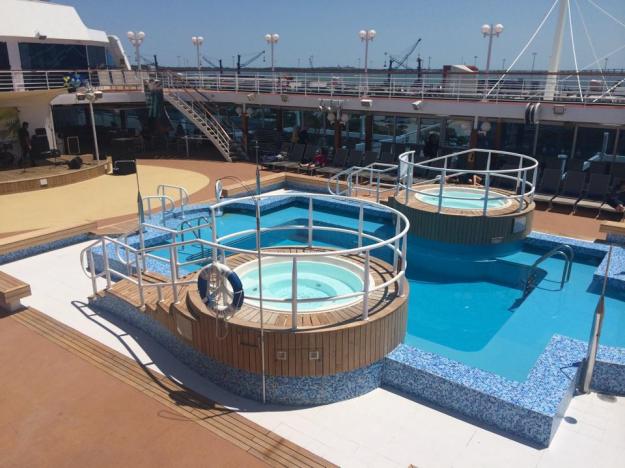
Photo taken during the 2013 government shutdown / Scott Kirkwood/NPCA
The impact of current U.S. Government Shutdown is far reaching – and travel is among the sectors being hit.
As of now, museums belonging to the Smithsonian and monuments, historic sites and national parks overseen by the divisions of the federal government are closed. Not only are certain federal employees related to these sites unable to go work and collect a salary, the ones connected to the travel sector that have to – mainly TSA agents and air traffic controllers – are mandated to be on the job but they’re not getting a paycheck while doing so.
Regardless of where you stand on the issues surrounding the shutdown, and not to make this post be a political one, those that work in the tourism sector are feeling its weight.
And so are we who rely on them in getting to and from and even see places. While we all are seeing what happens, and how those impacted financially by it having to make their own choices, I wanted to come up with some ideas of how one can adapt when traveling is impacted by the government shutdown. Here they are:

Creative Commons photo / whity
For Air Travel
Arrive earlier. I’ve seen news reports of waiting times at TSA security lines at airports reporting to be longer due to a shortage of TSA agents. There are agents who are not coming to work or calling out sick, so of course, less staff means more checking of passengers and test of patience. While the standard arrival time is usually two hours for a domestic flight, and three for international, try to go even earlier than day. True, it stinks to have to have hurry to and wait at the airport, but lines are anticipated to involve more waiting than we might assume. And you don’t want to increase your risk of being late to your gate.
Download the TSA app. There’s an app for just about everything, including one for the TSA that lists wait times at the security screening line. If you’re flying any time soon, you might want to download the TSA app. It will show you the wait times for the TSA lines in your airport. For example, in one news story, TSA lines at Atlanta’s Hartsfield-Jackson Atlanta International Airport are being reported at 120-plus minutes.
Put your stuff in order. Even as we wait, why not use that spare time to sort and pull out any items that we might fumble with getting out of our pockets or onto the x-ray belt. If you can hold something in or more so with your hands, try putting loose change in a clear plastic bag or place your cellphone within easy reach from your pocket, or making your laptop or 3-1-1 rule bag of toiletries easier to remove from your carry-on bag. A major timesuck at security checkpoints is being disorganized, so even before you leave home get your stuff in check. If you might not need it, don’t bring it.
Thank a TSA agent. Granted, we can have mixed feelings about TSA officials when going through security security – even I’ve been bummed about having to toss something I’ve forgotten to remove or being embarrassingly corrected – but these times are different. Remember, they’re still coming to work but not getting a dime for it. So, be kind to them; they’re human too. Put yourself in their shoes before yours have to come off.

Creative Commons photo / Ken
Getting to and from
Read up on the news but verify directly. With transportation, I’m not sure how far reaching the shutdown is in terms of other government-funded departments overseeing transportation such as Amtrak. As of yet, rail travel is still happening. Or seeing if new aircraft can roll out due delays in FAA certification, such as what Delta Air Lines might be finding with their anticipated new Airbus A220 planes. For peace of mind, check in with customer service departments; they might be fielding these questions already.
See if there’s more than one way to get there. If your destination doesn’t involve more than a day’s worth of transportation or one solid method, look at other options. Maybe take a bus, car-share or rental or go by train. If flying is a must, try to go with times where it’s not too busy or involving connections where you might have to hurry along to get to your next gate.

Creative Commons photo / Sue Waters
Visiting Places
Learn who’s in charge of running the place. It’s probably knowledge now that the U.S. National Parks are either officially closed down or still keeping their gates open but not being staffed by rangers and other personnel. While national parks may be open or not, state parks are mostly like still operational as they are state funded. And some popular landmarks are not under the control of the federal government. For starters, the Statue of Liberty and Ellis Island, two of NYC’s major attractions, are still open.
Be mindful of what you do while you’re there. While checking on whether or the national park you want to visit is still open to the public, I also strongly recommend on being smart if you’re going ahead. While you can enter some parks, you’re going to be on your own in some sense. Don’t hike or venture to trails or areas without being fully equipped or aware of your surroundings. Chances are, if you get lost or hurt, help might take a while due to not having available park rangers on hand.
Don’t be a jerk either. One heartbreaking bit of news involves permanent damage done to trees in Joshua National Park, because RVers cut them down to create roads that they weren’t supposed to do in the first place! Another problems involve over-flowing garbage cans and over-used toilets, because of a lack of resources to keep up with its removal. Practice a leave only footprints behind manta by taking your trash with you (especially in parks where bears are in habitat; news reports quote rangers saying that accessible trash will give them the impression of seeking out food). If you gotta, um, go, find out what you can do onsite or read up on this great post from REI on the topic.

Creative Commons photo / Damian Bariexca
Passports
Still apply for your passport. According to their website, the State Department is still processing applications for new passports or renewals. Go online to make an appointment or look for the nearest processing facility near you.
Have your travel plans been affected by the shutdown? Let me know in the comments below.













